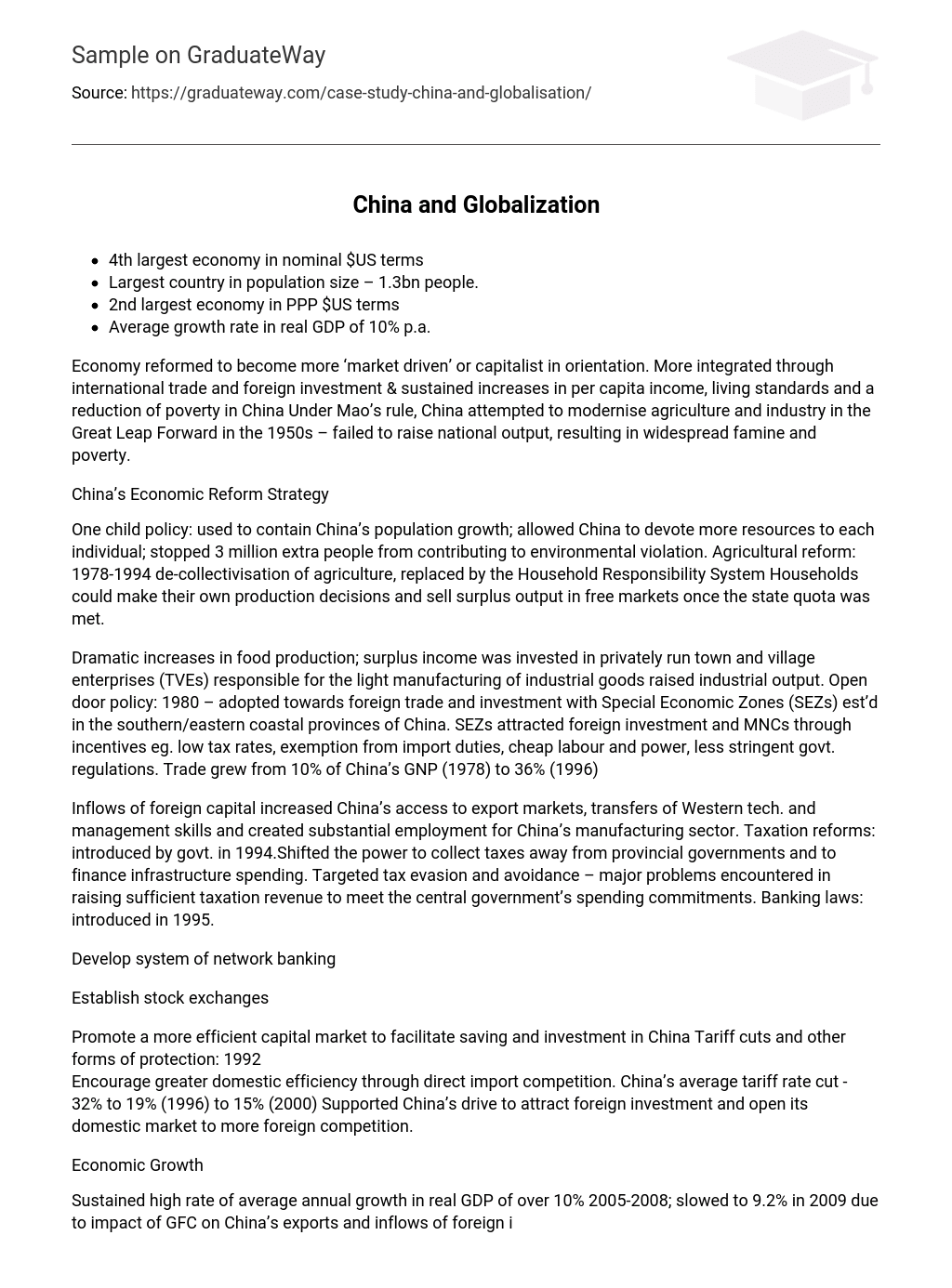- 4th largest economy in nominal $US terms
- Largest country in population size – 1.3bn people.
- 2nd largest economy in PPP $US terms
- Average growth rate in real GDP of 10% p.a.
Economy reformed to become more ‘market driven’ or capitalist in orientation. More integrated through international trade and foreign investment & sustained increases in per capita income, living standards and a reduction of poverty in China Under Mao’s rule, China attempted to modernise agriculture and industry in the Great Leap Forward in the 1950s – failed to raise national output, resulting in widespread famine and poverty.
China’s Economic Reform Strategy
One child policy: used to contain China’s population growth; allowed China to devote more resources to each individual; stopped 3 million extra people from contributing to environmental violation. Agricultural reform: 1978-1994 de-collectivisation of agriculture, replaced by the Household Responsibility System Households could make their own production decisions and sell surplus output in free markets once the state quota was met.
Dramatic increases in food production; surplus income was invested in privately run town and village enterprises (TVEs) responsible for the light manufacturing of industrial goods raised industrial output. Open door policy: 1980 – adopted towards foreign trade and investment with Special Economic Zones (SEZs) est’d in the southern/eastern coastal provinces of China. SEZs attracted foreign investment and MNCs through incentives eg. low tax rates, exemption from import duties, cheap labour and power, less stringent govt. regulations. Trade grew from 10% of China’s GNP (1978) to 36% (1996)
Inflows of foreign capital increased China’s access to export markets, transfers of Western tech. and management skills and created substantial employment for China’s manufacturing sector. Taxation reforms: introduced by govt. in 1994.Shifted the power to collect taxes away from provincial governments and to
finance infrastructure spending. Targeted tax evasion and avoidance – major problems encountered in raising sufficient taxation revenue to meet the central government’s spending commitments. Banking laws: introduced in 1995.
Develop system of network banking
Establish stock exchanges
Promote a more efficient capital market to facilitate saving and investment in China Tariff cuts and other forms of protection: 1992
Encourage greater domestic efficiency through direct import competition. China’s average tariff rate cut – 32% to 19% (1996) to 15% (2000) Supported China’s drive to attract foreign investment and open its domestic market to more foreign competition.
Economic Growth
Sustained high rate of average annual growth in real GDP of over 10% 2005-2008; slowed to 9.2% in 2009 due to impact of GFC on China’s exports and inflows of foreign investment. Implemented US$586bn fiscal stimulus package (Nov 2008) in response to GFC to maintain growth rate target of 8% in 2009-10. Infrastructure projects to rebalance growth from external sources Expanding household consumption and the services sector.
IMF forecast the Chinese economy to recover and grow by 10.3% (2010) and 9.6% (2011). Growth driven through foreign investment and international trade.
Transformations of China
- Planned/socialist economy & market/capitalist economy
- Agricultural economy & industrialised economy
- Rural peasant based society & urban based society
- Domestic focus & trade oriented focus, highly integrated with global economy
- China is a major world economic power, contributing substantially to global output, economic growth, trade and investment.
Some statistics
- Share of global GDP 13.6% (2010)
- Share of world exports of g/s = 9.4% (2010)
- Share of world population = 19.7%
- Nominal GDP (US$b) = 2,236 (2005) 6,515 (2011)
- Real GDP PPP (US$b) = 5,314 (2005) 11,174 (2011)
- Inflation (CPI % growth pa) = 1.8% (2005) 5% (2011)
- Sustained economic growth = 8-10% (1990s-2000s) – business investment and net exports Investment spending = 45% of GDP (2006) – incl. private/public on infrastructure Foreign investment funds to finance export industries = 42% of GDP (2007) Large current account surplus = 5.7% of GDP (2011)
- Low net external debt to GDP ratio = 3.1%
- Large foreign currency reserves = US$3,353bn (2011)
- Net lender of capital to the rest of the world
Economic Development
WB estimates that over the last 25yrs, poverty has been reduced by 400 million people in china, previously living on $US1/day. Between 1990/2001, reduction in income poverty most rapid, with incidence of people living below international poverty line falling by 130mil. Rapid rate of growth = export oriented strategy financed by direct foreign investment. Result: rising real incomes, significant improvements in material indicators (eg. real GDP per capita), non material indicators of development (eg. life expectancy, literacy)
Some statistics:
- Net direct foreign investment flows = US$147,791mil. (2008)
- Current account balance = US$426.1bn (2008)
- Adult literacy = 93.3% (2007)
- Doctors per 100,000 people = 106 (1990-2004)
- Life expectancy at birth = 63.2 years (1975) 73.5 years (2010) Population below poverty line = 9.9% (1990-2005)
- HDI = 0.368 (1980) 0.663 (2010)
- HDI rank = 89/169 (2010)
- GNI per capita (PPP US$ terms) – grew by 8.2% (1975-2010) to reach US$7,258 (2010)





